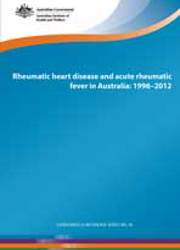Summary
Acute rheumatic fever (ARF) is rare in most developed countries, but rates among Aboriginal and Torres Strait Islander people are among the highest in the world based on available data. Rheumatic heart disease (RHD), which can be prevented by adequate treatment of ARF, also occurs at very high rates among Aboriginal and Torres Strait Islander people.
In 2009, the Australian Government's Rheumatic Fever Strategy was established to improve detection, monitoring and management of ARF and RHD through register-based control programs in the Northern Territory, Western Australia and Queensland.
Key findings
Jurisdictional incidence of ARF and prevalence of RHD
Data on the jurisdictional incidence of ARF and prevalence of RHD come from the Northern Territory, Queensland and Western Australian Rheumatic Heart Disease registers. It is not possible to directly compare these data as the registers are at different stages of establishment and coverage.
- There were 317 recorded cases of ARF in the Northern Territory between 2005 and 2010, 178 in Queensland between 2009 and 2011, and 21 in Western Australia between 1 July 2010 and 30 June 2011.
- There were 1,479 recorded cases of RHD in the Northern Territory (at 31 December 2010), 939 in Queensland (at 27 August 2012), and 158 in Western Australia (at 30 June 2011).
Large inequalities exist between Indigenous and other Australians
- Almost all cases of ARF recorded in the Northern Territory between 2005 and 2010 were for Aboriginal and Torres Strait Islander people (98%), with 58% in 5-14 year olds.
- In the Northern Territory in 2010, the prevalence rate of RHD among Aboriginal and Torres Strait Islander people was 26 times the rate for non-Indigenous people.
- Between 2007-08 and 2009-10, Aboriginal and Torres Strait Islander people had hospitalisation rates for ARF/RHD that were more than 6 times as high as for other Australians, but were less likely to have heart valve surgery if hospitalised.
- The death rate from RHD among Aboriginal and Torres Strait Islander people was 5 times as high as that of non-Indigenous Australians between 2004 and 2007.
RHD is a serious disease and has a substantial impact on individuals
- Regular, long-term antibiotic treatment is recommended for people with ARF or RHD. The proportion of patients in the Northern Territory who received more than 80% of their required doses improved from 23% in 2005 to 28% in 2010, though it still remains quite low.
- Heart surgery may be required to repair heart valve damage resulting from RHD. This is likely to explain why 68% of the hospitalisations for ARF/RHD in 2009-10 occurred in people aged 55 and over.
Preliminary material: Acknowledgments; Abbreviations; Symbols
1 Introduction
- Background
- Aims
- Data sources and methods
2 Acute rheumatic fever
- Incidence
- Deaths
3 Rheumatic heart disease
- Prevalence
- Deaths
4 Hospitalisations for acute rheumatic fever and rheumatic heart disease
5 Adherence to secondary prophylaxis in the Northern Territory
6 Expenditure on acute rheumatic fever and rheumatic heart disease
7 International comparisons
- Incidence of ARF
- Prevalence of RHD
- Hospitalisations and deaths
Appendixes
Appendix A: Detailed statistical tables
Appendix B: National data sources
Appendix C: Data and statistical methods
Appendix D: Diagnosis Guidelines
End matter: Glossary; References; List of tables; List of figures



